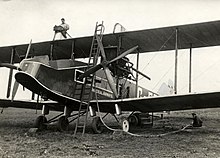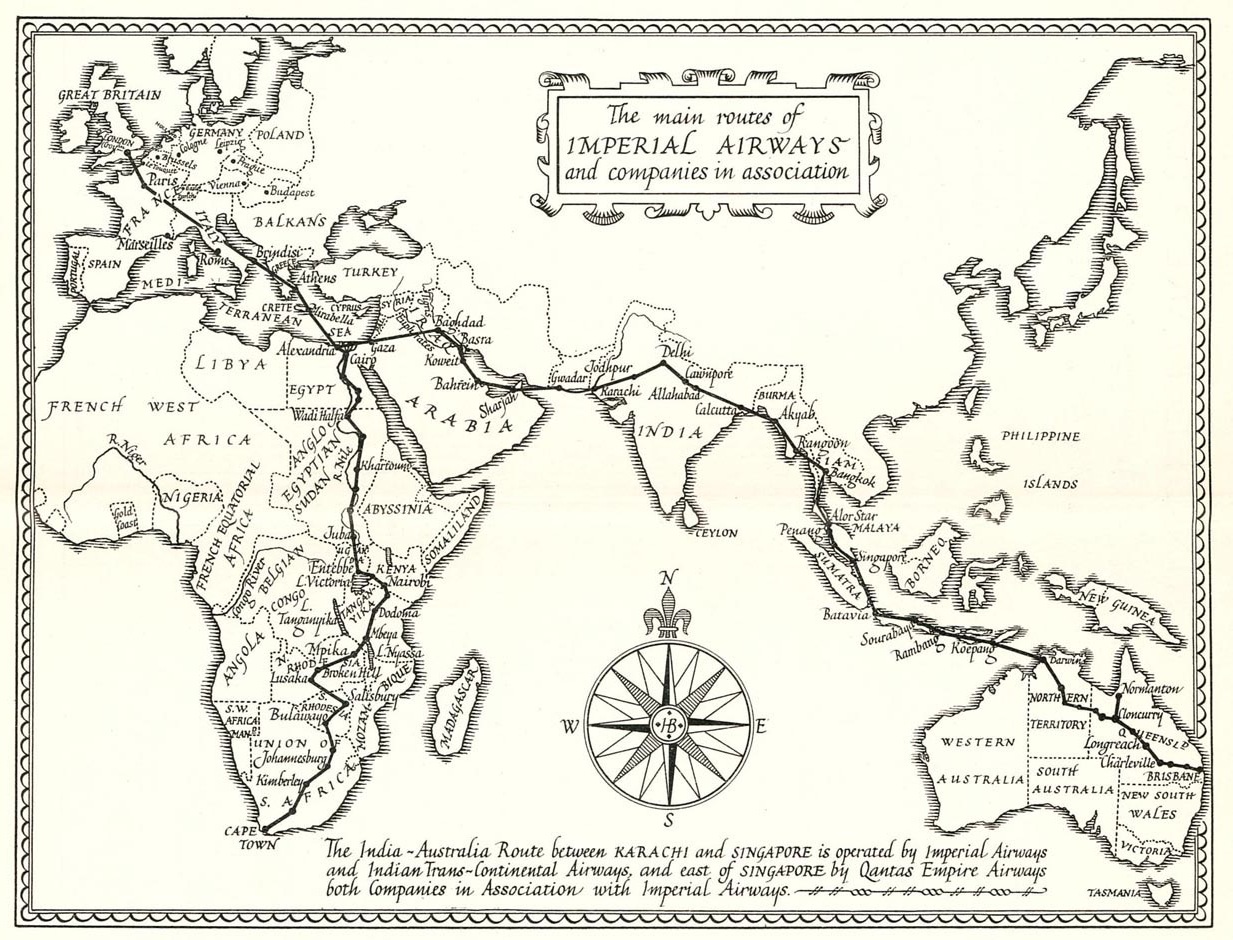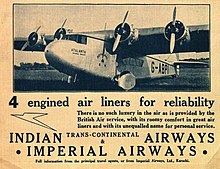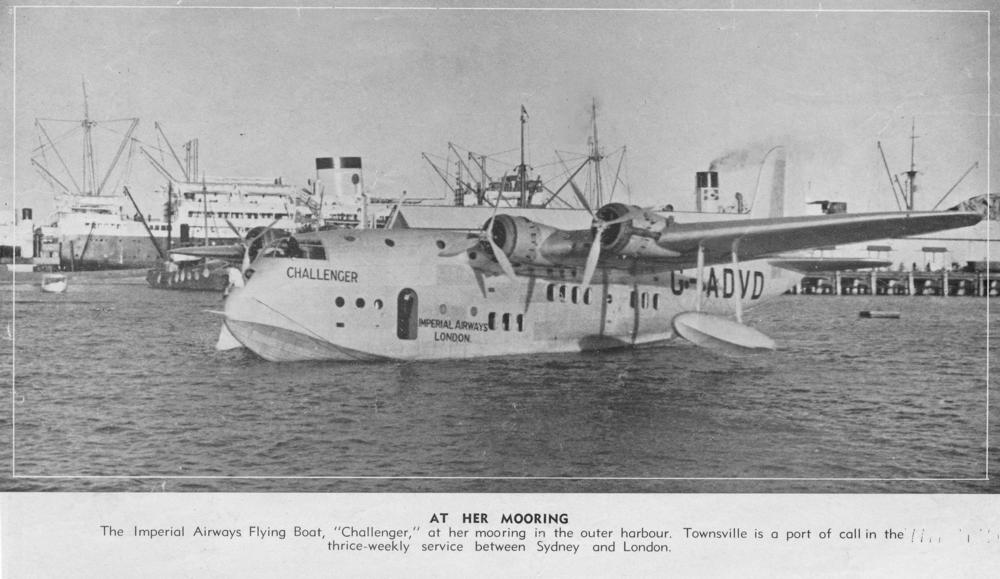
British Airways Airline
UK Wikipedia linkAmazing Imperial Airways airline
Imperial Airways never achieved the levels of technological innovation of its competitors and was merged into the British Overseas Airways Corporation (BOAC) in 1939. BOAC in turn merged with the British European Airways (BEA) in 1974 to form British Airways.


April 1935 map showing Imperial Airways'Air routes between England, India, Australia and South Africa
The establishment of Imperial Airways occurred in the context of facilitating overseas settlement by making travel to and from the colonies quicker, and that flight would also speed up colonial government and trade that was until then dependent upon ships. The launch of the airline followed a burst of air route surveying in the British Empire after the First World War, and after some experimental (and often dangerous) long-distance flying to the margins of Empire.

Regular services on the Cairo to Basra route began on 12 January 1927 using DH.66 aircraft, replacing the previous RAF mail flight.[11] Following two years of negotiations with the Persian authorities regarding overflight rights, a London to Karachi service started on 30 March 1929, taking seven days and consisting of a flight from London to Basle, a train to Genoa and a Short S.8 Calcutta flying boats to Alexandria, a train to Cairo and finally a DH.66 flight to Karachi. The route was extended as far as Delhi on 29 December 1929. The route across Europe and the Mediterranean changed many times over the next few years but almost always involved a rail journey.
 Imperial Airways Speedbird logo, mainly used in advertising and rarely on aircraft before 1939 Imperial Airways Speedbird logo, mainly used in advertising and rarely on aircraft before 1939 |
|
| Type | Private |
|---|---|
| Industry | Air transport |
| Predecessor | |
| Founded | 31 March 1924; 99 years ago |
| Defunct | 24 November 1939; 84 years ago |
| Fate | Merged with British Airways Ltd |
| Successor | British Overseas Airways Corporation |
| Headquarters | Croydon, England |
Regular services on the Cairo to Basra route began on 12 January 1927 using DH.66 aircraft, replacing the previous RAF mail fligh
Imperial Airways operated many types of aircraft from its formation on 1 April 1924 until 1 April 1940 when all aircraft still in service were transferred to BOAC.
| Aircraft | Type | Number | Period | Names | Notes |
|---|---|---|---|---|---|
| Armstrong Whitworth Argosy Mk.I | landplane City class |
3 | 1926–34 | Birmingham (crashed 1931), City of Wellington (later City of Arundel) (1934), Glasgow (retired 1934) | |
| Armstrong Whitworth Argosy Mk.II | 4 | 1929–35 | City of Edinburgh (wrecked 1926), City of Liverpool (wrecked 1933), City of Manchester (sold 1935) and City of Coventry (scrapped 1935) | ||
| Armstrong Whitworth Atalanta[46] | landplane Atalanta class |
8 | 1932–41 | Atalanta (sold), Andromeda (withdrawn 1939), Arethusa (renamed Atalanta), Artemis, Astraea, Athena (burnt 1936), Aurora (sold) and Amalthea (wrecked 1938). | For Nairobi-Cape Town leg on South Africa route & Karachi-Singapore leg on Australia route. |
| Armstrong Whitworth Ensign | landplane Ensign class |
12 | 1938–46 | Empire type (27 passengers) Ensign, Egeria, Elsinore, Euterpe, Explorer, Euryalus, Echo, Endymion and Western Type (40 passengers) Eddystone, Ettrick, Empyrean and Elysian | Everest & Enterprise delivered to BOAC. Intended to deliver 1st-class mail to the Empire by air. |
| Avro 618 Ten[45] | landplane | 2 | 1930–38 | Achilles (crashed 1938) Apollo (collided with radio mast 1933) | licence-built Fokker F.VII 3/m |
| Avro 652 | 2 | 1936–38 | Avalon and Avatar (later Ava) to RAF in 1938. | Prototypes for Anson bomber/trainer | |
| Boulton & Paul P.71A | landplane Bodiciea class |
2 | 1934–36 | Bodiciea (lost 1935) and Britomart (lost 1936) | Experimental mailplanes |
| Bristol Type 75 Ten-seater | landplane | 2 | 1924–26 | G-EAWY, G-EBEV (retired 1925) | ex-Instone Air Line used as freighters |
| de Havilland DH.34 | 7 | 1924–26 | ex-Instone Air Line G-EBBR (wrecked 1924), G-EBBT (scrapped 1930), G-EBBV (scrapped 1926), G-EBBW (scrapped 1926) and ex-Daimler Airway G-EBBX (wrecked 1924), G-EBBY (scrapped 1926), G-EBCX (wrecked 1924) | ||
| de Havilland DH.50 | 3 | 1924–33 | G-EBFO (damaged 1924 and sold), G-EBFP (scrapped 1933), G-EBKZ (crashed 1928) | G-EBFO used for surveys, later fitted with twin floats and sold in Australia | |
| de Havilland Highclere | 1 | 1924–27 | G-EBKI | freighter, destroyed in hangar collapse | |
| de Havilland Giant Moth | 1 | 1930-30 | G-AAEV (wrecked 1930) | crashed in Northern Rhodesia 2 weeks after hand over. | |
| de Havilland Hercules | 9 | 1926–35 | City of Cairo (wrecked 1931), City of Delhi (to SAAF 1934), City of Baghdad (withdrawn 1933), City of Jerusalem, City of Tehran, City of Basra (to SAAF 1934), City of Karachi (withdrawn 1935), City of Jodhpur (sold) and City of Cape Town (sold) | ||
| de Havilland Express | landplane Diana class |
12 | 1934–41 | Daedalus (burned 1938), Danae, Dardanus, Delia (wrecked 1941), Delphinus, Demeter, Denebola, Dido, Dione, Dorado, Draco (wrecked 1935), and Dryad (sold 1938) | All surviving aircraft impressed in 1941 |
| de Havilland Albatross | landplane Frobisher class |
7 | 1938–43 | Faraday (impressed 1940), Franklin (impressed 1940), Frobisher (destroyed 1940), Falcon (scrapped 1943), Fortuna (crashed 1943), Fingal (crashed 1940) and Fiona (scrapped 1943). | 1 used as long range mail carrier |
| Desoutter IB | landplane | 1 | 1933–35 | G-ABMW | Air-taxi No 6 |
| Handley Page O/10 | 1 | 1924-24 | G-EATH | ex-Handley Page Transport but never used | |
| Handley Page W8b | 3 | 1924–32 | Princess Mary (wrecked 1928), Prince George (retired 1929) and Prince Henry (retired 1932) | ex-Handley Page Transport | |
| Handley Page W8f Hamilton | 1 | 1924–30 | City of Washington (wrecked 1930) | Converted to twin engines and redesignated as W8g in 1929 | |
| Handley Page W9a Hampstead | 1 | 1926–29 | City of New York (sold 1929) | ||
| Handley Page W.10 | 4 | 1926–33 | City of Melbourne (sold 1933), City of Pretoria (sold 1933), City of London (crashed 1926) and City of Ottawa (crashed 1929). | ||
| Handley Page H.P.42E | landplane Hannibal class |
4 | 1931–40 | Hannibal (wrecked 1940), Horsa (impressed 1940), Hanno (wrecked 1940), Hadrian (impressed 1940) | (24 passengers) used on long "Empire" routes |
| Handley Page H.P.42W/H.P.45 | landplane Heracles class |
4 | 1931–40 | Heracles (wrecked 1940), Horatius (wrecked 1939), Hengist (wrecked 1937) and Helena (impressed 1940) | (38 passengers) on short "Western" routes, Hengist and Helena converted to H.P.42E. |
| Short S.8 Calcutta | flying boat | 5 | 1928–35 | City of Alexandria (wrecked 1936), City of Athens (later City of Stonehaven) (scrapped), City of Rome (wrecked 1929), City of Khartoum (wrecked 1935) and City of Salonica (later City of Swanage) (scrapped) | |
| Short Kent | flying boat Scipio class |
3 | 1931–38 | Scipio (wrecked 1936), Sylvanus (burned 1935) and Satyrus (scrapped 1938) | |
| Short Scylla | landplane | 2 | 1934–40 | Scylla (wrecked 1940) and Syrinx (scrapped 1940) | Landplane version of Kent, replacement for lost H.P.42s. |
| Short Mayo Composite | flying boat | 2 | 1938–40 | Mercury (scrapped 1941) and Maia (destroyed in German raid, 1942). | Long range piggyback Composite aircraft derived from Short Empire. |
| Short S.26 Empire | flying boat C class |
31 | 1936–47 | Canopus, Caledonia, Centaurus, Cavalier, Cambria, Castor, Cassiopea, Capella, Cygnus, Capricornus, Corsair, Courtier, Challenger, Centurion, Coriolanus, Calpurnia, Ceres, Clio, Circe, Calypso, Camilla, Corinna, Cordelia, Cameronian, Corinthian, Coogee, Corio, and Coorong. Carpentaria, Coolangatta, Cooee delivered but not used, and transferred to Qantas | provided mail and passenger service to Bermuda, South Africa and Australia |
| Short S.26 | flying boat G class |
3 | 1939–40 | Golden Hind, Golden Fleece and Golden Horn | Built for trans-atlantic service, impressed by RAF before entering revenue service. 2 returned to BOAC service and used until 1947. |
| Short S.30 Empire | flying boat C class |
9 | 1938–47 | Champion, Cabot, Caribou, Connemara, Clyde, Clare, Cathay, Ao-tea-roa (to TEAL as Aotearoa), Captain Cook (to TEAL as Awarua). | long range variant of S.23 |
| Supermarine Sea Eagle | flying boat | 2 | 1924–29 | Sarnia/G-EBGR (retired 1929) and G-EBGS (wrecked 1927) | ex-British Marine Air Navigation |
| Supermarine Southampton | 1 | 1929–30 | G-AASH | RAF S1235 on loan for 3 months to replace crashed Calcutta on Genoa-Alexandria airmail run. | |
| Supermarine Swan | 1 | 1925–27 | G-EBJY (scrapped 1927) | RAF prototype loaned for cross-Channel service | |
| Vickers Vanguard | landplane | 1 | 1926–29 | G-EBCP (wrecked 1929) | on loan from Air Ministry for evaluation |
| Vickers Vellox | 1 | 1934–36 | G-ABKY (wrecked 1936) | cargo/experimental flights. Crashed at Croydon in August killing pilots and two wireless operators | |
| Vickers Vimy Commercial | 1 | 1924–25 | City of London (wrecked 1925) | ex-Instone Air Line | |
| Vickers Vulcan | 3 | 1924–28 | G-EBLB/City of Brussels (wrecked 1928), G-EBFC (withdrawn 1924 unused), G-EBEK (loaned from Air Ministry for 1925 Empire Exhibition Display. | ||
| Westland IV and Wessex | 3 | 1931–37 | G-AAGW, G-ABEG (wrecked 1936), G-ACHI | 2 leased to other operators. IV (G-AAGW) upgraded to Wessex. |
|
|
|---|
Operations


|
||
Second World WarBefore the outbreak of war on 1 September 1939, the British government had already implemented the Air Navigation (Restriction in Time of War) Order 1939. That ordered military takeover of most civilian airfields in the UK, cessation of all private flying without individual flight permits, and other emergency measures. It was administered by a statutory department of the Air Ministry titled National Air Communications (NAC). By 1 September 1939, the aircraft and administrations of Imperial Airways and British Airways Ltd were physically transferred to Bristol (Whitchurch) Airport, to be operated jointly by NAC. On 1 April 1940, Imperial Airways Ltd and British Airways Ltd were officially combined into a new company, British Overseas Airways Corporation (BOAC), that had already been formed on 24 November 1939 with retrospective financial arrangements. |
||
Click here for more info British Airways BA

British Airways is a global airline, bringing people, places and diverse cultures closer together for more than 100 years

In February 2016, Boeing launched a passenger-to-freighter conversion program, designated as Boeing 737-800BCF

The 747-400F (Freighter) is an all freight version of the 747-400. While using the updated systems and wing design versions,

The 747-400 and earlier versions had proven to be a very popular freighter, carrying the world's

The Boeing 767 is an American wide-body aircraft developed and manufactured by Boeing BCA

The 777 Freighter (777F) is an all-cargo version of the twinjet, and shares features with the -200LR



|
|---|
|
|
|---|
|
|---|
|
|||||||||||||||||
|---|---|---|---|---|---|---|---|---|---|---|---|---|---|---|---|---|---|
|
|||
|---|---|---|---|
|
|||